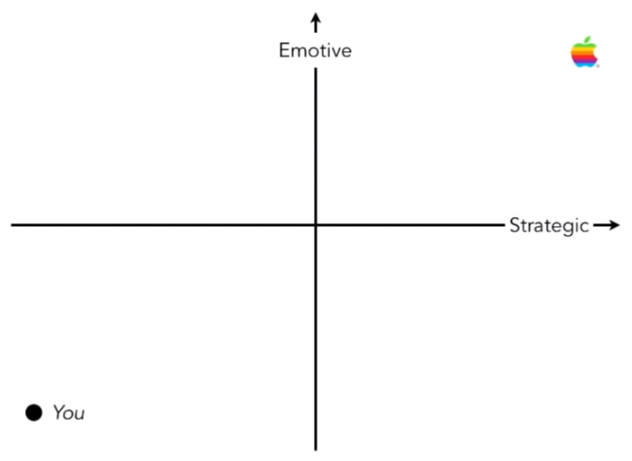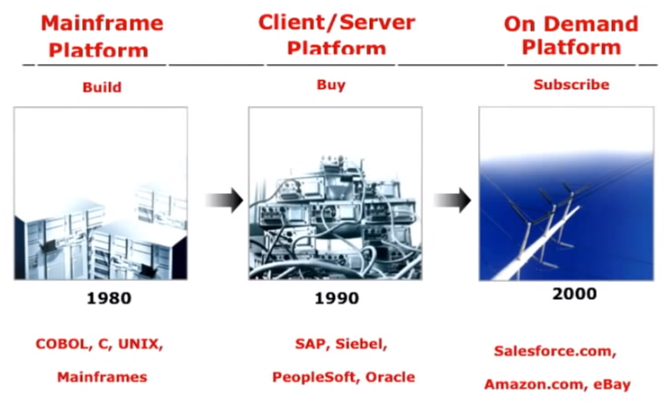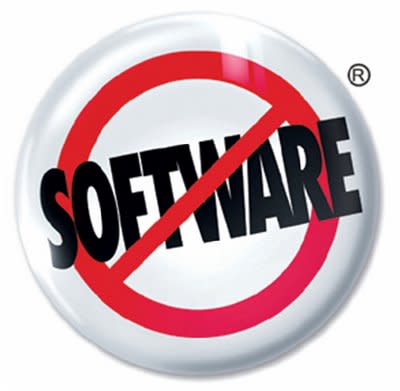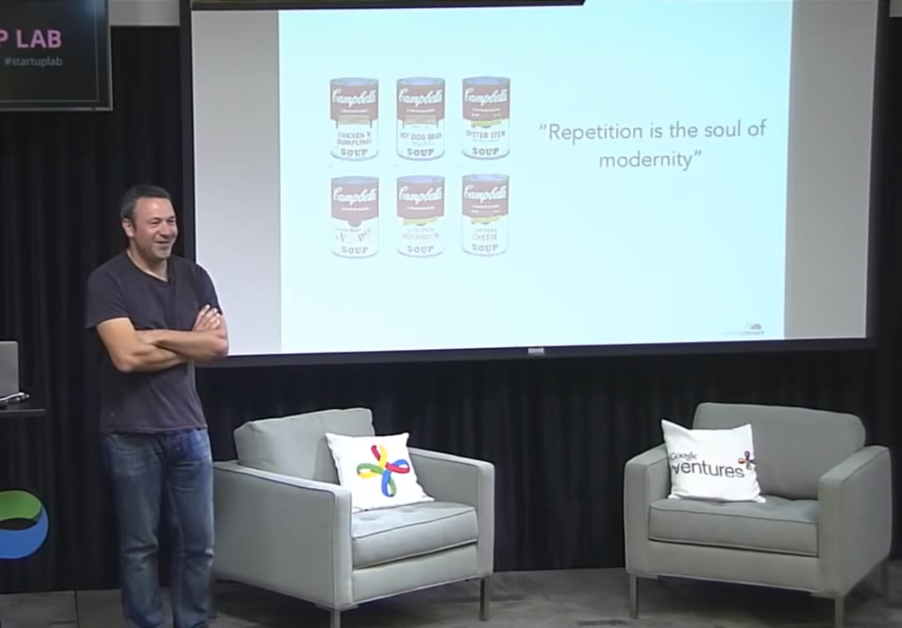Adam Gross, the head of product at Heroku, has a long history in companies that now are some of the biggest players in technology, but he facilitated their growth back when they were still upstarts. Companies like Salesforce and Dropbox. His interests and expertise lie in app development and cloud infrastructure along with CRM and customer facing systems, two areas he finds "oddly related."
Gross spoke at Google Ventures' Startup Lab workshop last year about the rules he's found that govern his approach to telling the story of the companies he works for and advises.
"Top Down" vs. "Bottoms Up" Marketing

The premise of Gross' talk isn't about earning more Facebook Likes or convincing users to Tweet out recommendations. His focus is on telling your company's story. On some level, it's the old fashioned view of marketing, but one that has changed in important ways. The product team that gets that story and the new ways to tell it are at an advantage.
But that's not the hot topic in marketing today, Gross notes. The hot topic today is organic marketing. Building trust. Using social channels to get your users to create buzz for you. This kind of marketing has become the domain of technologists. That fact itself has become its own story.
"One of the things that's really, really interesting, that's happened over the past five years or so is the 'bottoms up' side of marketing," Gross says. "Really the stuff we think about in terms of customer acquisition, activation, retention, funnel, all of those marketing mechanics, which are, of course, essential to a company's success.
"Ten years ago you didn't find technologists and product people talking about those problems," he continues. "As a marketer, it's fascinating and encouraging that there are so many new ideas coming into that space."
The "top down" part—a company's positioning, pricing, PR and sales enablement—is still shrouded in mystery, Gross argues. Many of the people he interacts with in the startup community, he says, see these practices as "something that somebody else does."
The goal of his presentation: demystify "top down" marketing and show its importance. To do so, he employs a seven-point outline.
7 Product Marketing Tactics
1. The Grand Unified Theory of Marketing

As Gross talked to companies about breaking through the din, he realized he was talking to them about two different topics: strategy and emotion. The more he thought about it, the more he realized that both of those factors are recipes for success in a marketing plan. And, in fact, the most successful companies win on both counts.
"Fundamentally, what are the properties and characteristics of companies we admire most and really want to emulate," he says, giving Apple as an example of a company that absolutely dominates in both ways. They create products that people fixate on, but they also come up with powerful channels like the iTunes store or they completely shake up mobile computing with the iPhone. They are both very strategic and emotionally resonant.
Strategic: Driving a respective industry. Influential. At the heart of that industry.
Emotive: "Apple is this incredibly emotive, personal kind of brand."
It's the combination of these two things that makes Apple so powerful.
People compare Apple to Harley-Davidson, but that's just based on the emotive side. Motorcycle making is probably not a very strategic business.
So how should startups—the "you" in the graphic above—who by default possess low emotive and low strategic products think about the path to success? There are actually two paths to get to the same point, and more often than not the choice of the path is dictated by the kind of company you are. Are you working to win enterprise/business clients or are you working to win over consumers?
Enterprise/B2B: Tends to be strategic first and then emotive.
Consumer: Emotive first and then strategic.
"A lot of enterprise companies tend to do well on the strategic dimension," he says. "Oracle is clearly a strategic company." Oracle has no emotive quality at all. Just look at their ads. They buy expensive space and hardly seem to put any thought at all into what they put there. Intel, another strategic company, appears to be trying to move up the emotive continuum, but it just isn't.
In fact, it can be really embarrassing when a company grasps for that emotive quality and fails. For example, Sun Microsystems: 13 years ago it was really strategic, but now they are barely important after being acquired. In 2001, Sun announced that Britney Spears would be the spokesperson for Java. Gross called it maybe the saddest moment ever of a company trying to move up the emotive dimension.
"Strategic First" Example: Salesforce
In early 2000s, contact management was a crappy commodity, low-end, nasty space, Gross says. Crappy address managers were how people managed contacts. Eventually, a piece of this rises up to be a product at the core of many businesses, called Salesforce. Dropbox's rise from the crappy world of FTP products is similar.
"If you're familiar with Salesforce, you can appreciate the fact that the brand is a little more lively and fun than something like an SAP or an Oracle brand," he says. "The rule was 10 years ago, that's just how enterprise brands are. They don't need to do this." Salesforce did decide to work on being a brand with some emotional weight, though. As they started to win over people with the quality of their product, they went all in with making an emotional connection.
If you're familiar with Salesforce, you can appreciate the fact that the brand is a little more lively and fun than something like an SAP or an Oracle brand.
Adam Gross, early Salesforce and Dropbox employee
If you go to a Salesforce event, they have off the charts level of production values, Gross says, noting they've gone so far as to pay the person who suits up as the San Francisco Giants' mascot to play their mascot. Because the brand cares so much about representing the emotive quality of the brand. Still, it's worth nothing, they started by breaking through strategically and once they got traction they doubled down on the emotive side.
During the Q&A, Gross circled back to B2B companies and pointed out a big mistake he sees them make in their messaging and planning over and over. There's no difference, he said, between marketing to enterprise and small business anymore. The only difference is the size of the sale. The idea is a holdover from the days when the channel to small businesses was direct mail and the channel to enterprise was salespeople. The only difference now is that at enterprise level you are selling to a department head and at the small business level you are selling to its CEO.
They will each respond to the same sales message and you will almost certainly reach them the same way, with some kind of web enabled channel that reaches each just as easily.
"Emotive First" Example: Twitter and Instagram
Twitter and Instagram started as companies that most users didn't really see the point of at first. Both worked to win users over. Both start to grow purely on emotional weight, and at some point there's a shift where it becomes a challenge to Facebook, after just starting as a fun thing.
The least emotive thing you can do, ever, is use stock photography.
Adam Gross, early Salesforce and Dropbox employee
Gross did a quick aside here on the emotive aspect for a company at any stage: "The least emotive thing you can do, ever, is use stock photography. When I see a company that puts stock photography on their website or on their decks, it's just like 'we couldn't care less about representing real emotion.'"
2. Industry Narrative

The slide above, now over 10 years old, is the most famous slide Gross says he's ever made. It's been seen lots of times and Salesforce is still doing new versions of it to this day.
"Salesforce frames itself as being part of an industry transformation," he says. "The shift from client server, represented by companies like SAP and Oracle, to … this internet model of distributing services."
Why did Salesforce choose this message over touting the look of its product? The answer: to put the company in a broader discussion, affecting its position on the strategic dimension, Gross says. Box, which struggled to gain the same kind of momentum Dropbox did in its early days, has now smartly inserted itself in this cloud discussion, too.
"For the companies that we really think, 'Wow, these guys are an important player in the industry,' there's always some core industry transformation narrative that's the engine behind it," he says, providing two examples.
Zynga: Console gaming to social gaming and casual gaming
Facebook: Discovery and the corresponding ad dollars moving from search to social
"It's amazing how the cloud story continues to be the gift that keeps on giving in terms of powering this kind of narrative," he says. "I thought it would have been played out a decade ago."
So the question is: What is your industry changing narrative? Gross bets it's some derivation of, "The internet changes everything." All we are doing every day, he points out, is referencing endlessly how this thing—the internet—is changing our lives and the economy.
"I don't care if you're selling digital door handles or projectors," Gross says, "there's some 'the internet changes everything' line that at least puts you on that strategic differentiation path," Gross says.
3. Differentiation

"It's better to be different that it is to be right," is one of Gross' favorite Salesforce lines.
Accuracy is not the goal with your product, he explains, the goal is to be different (that is, stand out).
He ran into Craig Newmark of Craigslist one day on the train. Newmark had seen Salesforce's "No Software" logo and scratched his head about it. He asked Gross about the slogan, saying, there's got to be software, right?
That's not the point, though. It's not about saying there is no software. Don't get lost in being so accurate that you can't say what you want to say in powerful, simple ways. That logo was about positioning Salesforce against an industry model that sold software in a box, Gross says. It was delivering your contacts via the internet, not software on your server. That's what made it fundamentally different. That was the point.
"The essence of the positioning was the negation of something else," he says.
Without differentiation, it's hard to imagine how you ultimately become successful. When you think about the limited amount of attention you have, if it's not immediately clear what's different about you, you're not going to hold attention, Gross argues
One of Gross' biggest PR successes came when he convinced a reported to tell a different story than the one he sat out to tell. He was at Dropbox when The Economist called in 2009 or 2010. They asked, 'Why is Google losing out to startups?' That was a story that Dropbox didn't want to do. The story Dropbox wanted was about competing against a model where PCs hooked up by LANs shared files within companies. The article ended up being more about what's wrong with the Windows model.
4. Ingredient Branding

The ingredients in your product can be key, and it could be that one ingredient will end up representing everything that makes your product stand out. Gross tells the story of seeing a vendor in San Francisco selling traditional treats like Ho Hos and Pop-Tarts, except they were all made with hyper-artisanal ingredients. The ingredients were what made them different.
"Why ingredient branding is so important is because it becomes the conceptual manifestation of all of those ideas about what makes your company and your products different," Gross says. You want somebody to say your product is different because it has this one thing—this one specific thing that you've identified.
For a technology example, when the Apple personal computer came out, the mouse wasn't the key technical difference for the Mac, but the mouse came to represent everything that was fundamentally different about the Mac.
Similarly, once upon a time, the TiVo had a big "PAUSE" button. It was the only thing that could pause live TV. So they made the pause button big because it told the story of how their product was fundamentally different.
5. Leveraged Acquisition

Partnerships can be an powerful way for two companies to emphasize what they want to drive home about their narrative.
A Minimum Viable Product (MVP) can just as easily be thought of as Minimum Viable Marketing for the sake of a product or a partnership.
If you think about this from a product and marketing point of view, Gross says, you can ask yourself what's the smallest, simplest product you can create that will carry your message through another company's channel. Ultimately, with the goal of acquiring more customers for your own business.
Skype and Salesforce, Gross says calling to mind an example of this tactic, teamed up in their early day, almost a decade ago. Salesforce initiated the partnership as a way to position itself near another next generation company—Skype was disrupting telephony like Salesforce was disrupting contact management.
It turned out that with some quick coding, you could plug your contacts into Skype and whip together a conference call. It was easy to write, but both companies wrapped it in this larger message of how software was changing communication. It became a story. It got in the Wall Street Journal three times.
Importantly, he emphasizes that this wasn't a complex business development exercise. There weren't contracts and long negotiations. It was hashed out quickly between product people who each had goals they wanted to achieve and realized they could help each other.
6. Repeat

"Why are we out there with the same message again and again and again?" Gross asks.
If you go to the Salesforce conference, DreamForce, you'll still see some derivation of the slide Gross created 11 years earlier about how Salesforce is transforming its industry. The job of the product marketing people is to repeat that core narrative until they can't stand it.
In fact, there are lots of ways to do it. One of them is to ask yourself what's the smallest tweak you can give to your product to let you get out there and do a new "product launch" and tell that story again.
"One of the most important lessons I learned at Salesforce is how to launch the same product multiple times," Gross says. "Again, it comes down to that 'Minimum Viable Marketing' product, what's the absolute smallest piece of thing that we need to credibly add to make this thing new?"
One of the most important lessons I learned at Salesforce is how to launch the same product multiple times.
Adam Gross, early Salesforce and Dropbox employee
Each launch is just an opportunity to repeat your core message, to continue your narrative. But to say the same thing "again and again and again" is counterintuitive to the way we think about communication, Gross admits. So what he tries to do is help people understand that they'll repeat that message until their mouth goes dry, until they can't stand to hear it another time.
"You're Skynyrd, and you're going to play 'Free Bird' for the next 40 years, and you should love it," he says. "That is your job once you have that message—to repeat it as much as you can possibly bear."
7. PR APIs
Controversy
Acquisition
Financial / Funding (IPO, quarterly results)
Partnership
Product Launch
Hiring
Metrics
The channels that will tell the story of your company have formats that they want to receive that narrative in. Gross says that these are, effectively, APIs.
"PR has APIs. So don't try to violate them or invoke APIs that don't exist, because it won't work," he says. "Your job is to format your stories for those APIs."
Those APIs also have rank to them in terms of importance. There are certain APIs that you can invoke that will have the least impact and those that will have the highest impact, which Gross has ranked from top to bottom (above).
Your job is to format your stories for those APIs.
Adam Gross, early Salesforce and Dropbox employee
Controversy will always get coverage. Uber's entire PR strategy is about controversy. When television companies threatened Aereo, it was the best possible PR coup. However, some companies get confused about controversy and try to stir up a controversy that doesn't mean anything to the consumer. One trap here is making the controversy about a competitor rather than a model. A company can go out and say that they are the "Whatever-killer" but if that's all they say it won't resonate. Potential customers need to understand what's different.
Salesforce didn't go after Oracle. It went after keeping your contacts on your own servers. Dropbox didn't go after Microsoft, it went after LANs.
During the Q&A, Gross says "companies get obsessed, they get a psychosis, about how they frame themselves in an industry … that's not healthy."
So if you scan the list above, one thing product teams can do is to try to find ways to make their next move one that they can shift up a notch on the API list. If you are about to do a product launch, for example, find some way to team up with another company as you do so and position it as a partnership.
More Product Marketing Tactics
Have you or your team found one of Gross' product marketing tactics to be effective for your company? Or have you found another tactic that's been as impactful? Please share in the comments below.
You might also enjoy this article: "Past the Pop-Up: 10 Email Marketing Tactics You've Never Tried"
Credits: Video of Adam Gross talk courtesy Google Ventures. Adam Gross photo from Google Ventures on YouTube. TiVo remote image courtesy Wikimedia.





